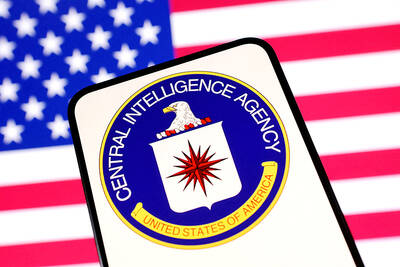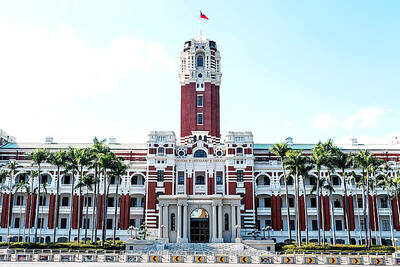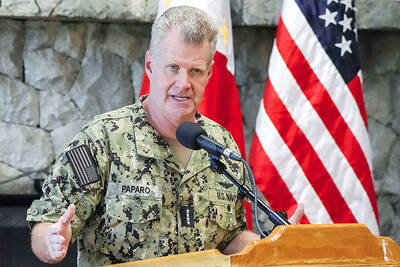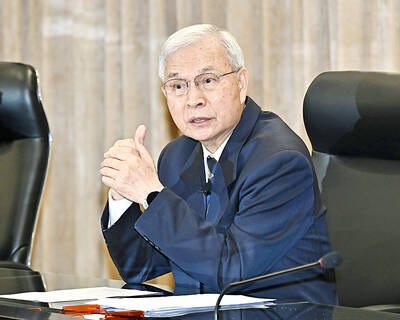Two Japanese and a Japanese-born American have won the Nobel Prize in physics for discoveries in the world of subatomic physics, the Royal Swedish Academy of Sciences announced yesterday.
American Yoichiro Nambu, 87, of the University of Chicago, won half of the prize for the discovery of a mechanism called spontaneous broken symmetry in subatomic physics. Makoto Kobayashi and Toshihide Maskawa of Japan shared the other half of the prize for discovering the origin of the broken symmetry that predicts the existence of at least three families of quarks in nature.
“Spontaneous broken symmetry conceals nature’s order under an apparently jumbled surface,” the academy said in its citation. “Nambu’s theories permeate the standard model of elementary particle physics. The model unifies the smallest building blocks of all matter and three of nature’s four forces in one single theory.”
The Japanese-born Nambu moved to the US in 1952 and is a professor at the University of Chicago, where he has worked for 40 years. He became a US citizen in 1970.
“As early as 1960, Yoichiro Nambu formulated his mathematical description of spontaneous broken symmetry in elementary particle physics,” the citation said.
“Spontaneous broken symmetry conceals nature’s order under an apparently jumbled surface. It has proved to be extremely useful, and Nambu’s theories permeate the Standard Model of elementary particle physics,” it said.
Kobayashi and Maskawa “explained broken symmetry within the framework of the standard model but required that the model be extended to three families of quarks.”
Kobayashi, 64, works for the High Energy Accelerator Research Organization, or KEK, in Tsukuba, Japan. Maskawa, 68, is with the Yukawa Institute for Theoretical Physics at Kyoto University in Japan.
“The spontaneous broken symmetries that Nambu studied differ from the broken symmetries described by Makoto Kobayashi and Toshihide Maskawa,” the academy said. “These spontaneous occurrences seem to have existed in nature since the very beginning of the universe and came as a complete surprise when they first appeared in particle experiments in 1964.”
The academy added that it was only in recent years that scientists have been able to confirm the explanations that Kobayashi and Maskawa proffered in 1972.
“These predicted, hypothetical new quarks have recently appeared in physics experiments. As late as 2001, the two particle detectors BaBar at Stanford ... and Belle at Tsukuba, Japan, both detected broken symmetries independently of each other. The results were exactly as Kobayashi and Maskawa had predicted almost three decades earlier,” the citation said.
Maskawa yesterday paid tribute to Nambu.
“I am happy that Mr Nambu has won it. I thought there was a bigger chance this year,” Maskawa said, as quoted by Jiji Press.
Japanese Prime Minister Taro Aso was overjoyed when he learned about the Nobel prize during a high-level meeting on the global financial crisis, a minister said.
“When we heard the news, all of us clapped and the prime minister actually jumped for joy, saying, ‘That’s great news,’” Japanese Finance Minister Shoichi Nakagawa told reporters.

The CIA has a message for Chinese government officials worried about their place in Chinese President Xi Jinping’s (習近平) government: Come work with us. The agency released two Mandarin-language videos on social media on Thursday inviting disgruntled officials to contact the CIA. The recruitment videos posted on YouTube and X racked up more than 5 million views combined in their first day. The outreach comes as CIA Director John Ratcliffe has vowed to boost the agency’s use of intelligence from human sources and its focus on China, which has recently targeted US officials with its own espionage operations. The videos are “aimed at

STEADFAST FRIEND: The bills encourage increased Taiwan-US engagement and address China’s distortion of UN Resolution 2758 to isolate Taiwan internationally The Presidential Office yesterday thanked the US House of Representatives for unanimously passing two Taiwan-related bills highlighting its solid support for Taiwan’s democracy and global participation, and for deepening bilateral relations. One of the bills, the Taiwan Assurance Implementation Act, requires the US Department of State to periodically review its guidelines for engagement with Taiwan, and report to the US Congress on the guidelines and plans to lift self-imposed limitations on US-Taiwan engagement. The other bill is the Taiwan International Solidarity Act, which clarifies that UN Resolution 2758 does not address the issue of the representation of Taiwan or its people in

US Indo-Pacific Commander Admiral Samuel Paparo on Friday expressed concern over the rate at which China is diversifying its military exercises, the Financial Times (FT) reported on Saturday. “The rates of change on the depth and breadth of their exercises is the one non-linear effect that I’ve seen in the last year that wakes me up at night or keeps me up at night,” Paparo was quoted by FT as saying while attending the annual Sedona Forum at the McCain Institute in Arizona. Paparo also expressed concern over the speed with which China was expanding its military. While the US

SHIFT: Taiwan’s better-than-expected first-quarter GDP and signs of weakness in the US have driven global capital back to emerging markets, the central bank head said The central bank yesterday blamed market speculation for the steep rise in the local currency, and urged exporters and financial institutions to stay calm and stop panic sell-offs to avoid hurting their own profitability. The nation’s top monetary policymaker said that it would step in, if necessary, to maintain order and stability in the foreign exchange market. The remarks came as the NT dollar yesterday closed up NT$0.919 to NT$30.145 against the US dollar in Taipei trading, after rising as high as NT$29.59 in intraday trading. The local currency has surged 5.85 percent against the greenback over the past two sessions, central